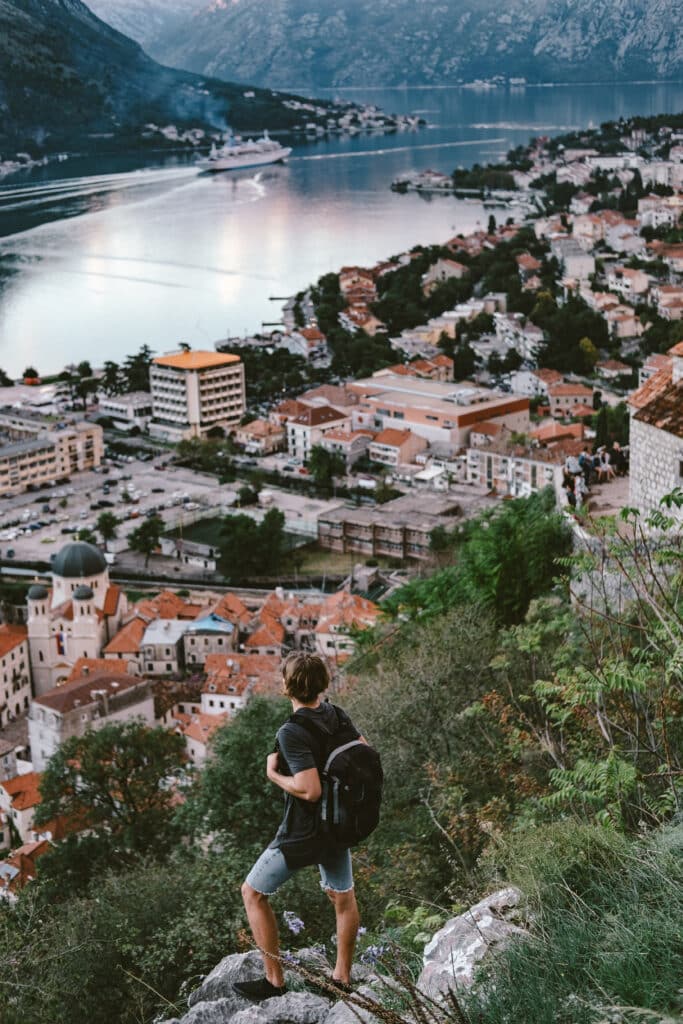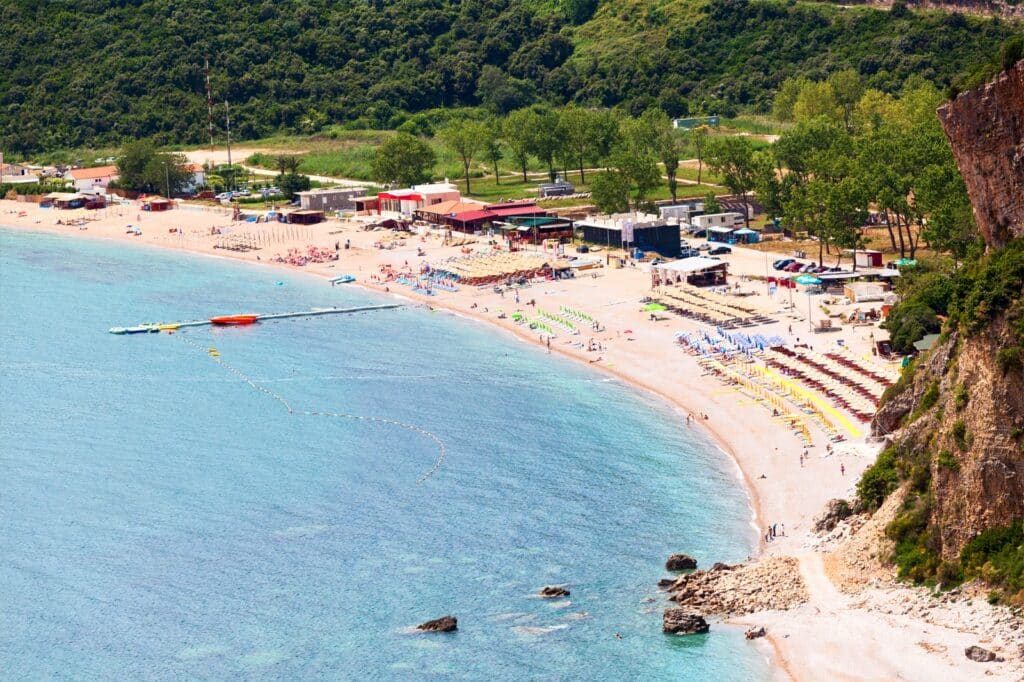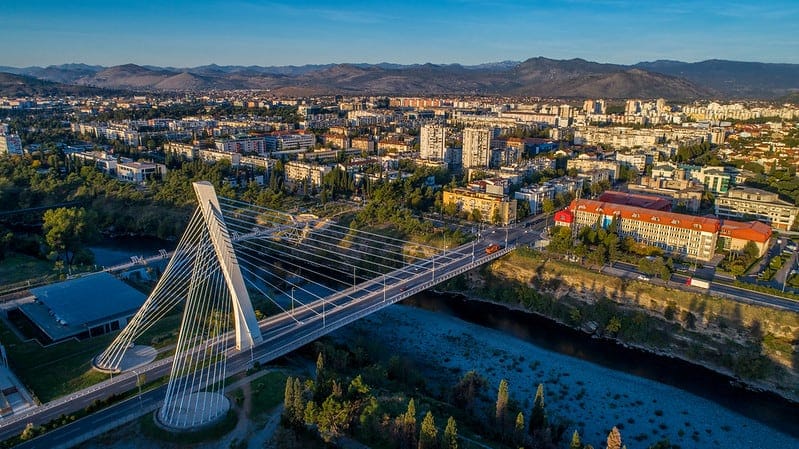Retiring in Montenegro in 2022.
If you are looking to invest as an expat or high-net-worth individual, which is what I specialize in, you can email me (advice@adamfayed.com) or use WhatsApp (+44-7393-450-837).
Table of Contents
Overview
Retiring in Montenegro should be ideal for you if you’re looking for a terrific natural environment, advantageous tax rates, and high quality of living. Imagine a version of Croatia, but less expensive, less cumbersome regulations, and with more to offer amid its tiny size.
Montenegro is strategically located in the Balkans region of Europe, making a number of locations accessible. It has some of Europe’s most rocky terrains, which are perfect for hikers and other outdoor enthusiasts. If you’re retiring in Montenegro and love to sail, meanwhile, you can benefit from the country’s convenient location on the Adriatic coast.
Montenegro combines Eastern and Western influences, like most of the Balkan region. Italian influences can be seen in the architecture and creative trends, while Turkish and Greek influences can be found in the cuisine. A place like Montenegro would be great if you enjoy numerous European traditions.
Both tourists and expats find the weather to be a major lure in Montenegro. Many people anticipate it to be cold, yet it has weather that is similar to that of other countries along the Adriatic Sea, such as Italy and Greece.
High summertime temperatures can get as high as 27 degrees Celsius. While it can get very cold inland throughout the winter, it keeps a little warmer by the ocean. Unsurprisingly, it gets colder further up.
The finest months for weather in Montenegro are May through September, which are usually cloudy. Retiring in Montenegro can be quite gratifying for you if you like warmth without a lot of sun.
In terms of transportation, there are seasonal flights to Dubai, London, Frankfurt, and Paris from the international airport at Tivat, which is located on the coast. The airport also offers direct flights to Belgrade and Moscow.
With frequent direct flights to destinations around Europe, the capital city of Podgorica boasts a good international airport.
Montenegro is two hours from Paris and one hour from Vienna distant by air. Traveling across the continent is affordable because Montenegro is served by a number of cheap airlines.
Retiring in Montenegro: Residency
Montenegro does not have a specific program for retirement residency. The quickest way to obtain a temporary residence permit if you’re set in retiring in Montenegro is probably by purchasing a home.
But Montenegro in general has a similar residence application process with the rest of the Schengen region. If you are a citizen from certain nations (with which Montenegro has a current treaty with, for instance) you are permitted a visa-free stay of up to 90 days in the nation.
If you’re retiring in Montenegro, you can secure a residence permit to live in the country full time by acquiring a property or start a Montenegrin business. Operating costs of such enterprise usually hit roughly $2,000 to 3,000 a year.
Foreigners are free to purchase real estate in Montenegro without any limitations, and the procedure is straightforward. However, before finalizing the transaction, you’ll need a legal office to conduct due diligence on the property.
Property purchases can be made privately or through real estate brokers. Of course, it makes sense to use official methods if you’re a foreign buyer. It greatly simplifies things, especially if you don’t speak either the Montenegrin or Serbian language.
In Montenegro, getting a mortgage is likewise not too difficult for expats. The typical down payment for real estate is 10%, and many banks in Montenegro are happy to arrange a mortgage for foreign buyers.
As a foreigner, you can also purchase land for development. But in order to do this, you must establish a business in Montenegro and purchase it through the corporation. This qualifies for an employment visa, making it a reasonable path to residency and property.
In addition, the country allows making certain investments in exchange for citizenship. This offer targets retirees with high net worth. If you qualify under this bracket, you need to invest about 450,000 euros in some particular real estate developments in coastal regions, or 250,000 euros in certain approved real estate developments inland, as well as make a donation worth 200,000 euros to the Montenegrin government.
Although the above investment scheme will require a significant amount of money, it will greatly trim the amount of time needed to acquire citizenship in Montenegro. It is also a clear-cut process in obtaining not just residency but citizenship, which is even better than the complex procedures offered in many other nations.
The time it takes to obtain citizenship in the country is usually 10 years.

Retiring in Montenegro: Cost of Living
Naturally, where you reside and the type of lifestyle you lead will affect how much retiring in Montenegro will cost. Usually though, the country is regarded as one of the most affordable nations in Europe.
Retiring in Montenegro would in general cost you less than if you would retire in the US. For assessment, global cost of living data aggregator Numbeo estimated that you must have about $2,024 in Montenegrin capital Podgorica (as of the time of writing) to be able to maintain the same standard of life that you can have with $6,900 in Washington, DC. These figures assume that you are renting in both cities.
A meal at an inexpensive restaurant in Montenegro is estimated to cost 6 euros, while a mid-range restaurant can charge 27 euros for a three-course meal for two.
Rent for one-bedroom apartments inside and outside Montenegro’s city center cost 352 euros and 267 euros on average per month, respectively. Rent prices in the country’s city center are way cheaper than in the US, which cost $1,666 on average per month.
The cost per square meter for buying an apartment within Montenegro’s city center is at 1,669 euros, while that outside of the area is at 1,231 euros. For comparison, acquiring an apartment in the US’ city center costs about four times as much at $4,513 on average per square meter.
For utilities such as electricity, heating, cooling, water, garbage, expect to pay an average of about 98 euros per month when retiring in Montenegro. These vary according to the size of your home, how much you use them, the time of year, and other factors. Meanwhile, the cost of the internet is about 25 euros per month, however, you won’t find fast connection speeds outside of main cities. Although outdated connection technologies are still used in rural areas, the average download speed nationwide is about 59Mb/s.
The overall cost of living in Montenegro for a family of four can reach an estimated average of 1,672 euros per month, while a single person can live off 479 euros a month, both excluding rent.
Retiring in Montenegro: Crime and Safety
Retiring in Montenegro is secure because of the low crime rate. Violent crime in the country, specifically, is at a relatively lower level when compared to other countries.
The crime rate is substantially lower in well-known beach communities like Budva. Apart from corruption, all sorts of crime are regarded as low or very low. In light of this, choose a smaller town if you’re worried about crime when deciding where to settle.
During the May to September summer tourist season, street crime increases significantly in the coastal tourist areas. If you’re visiting crowded attractions or shopping areas exercise common sense and protect your belongings and stick to well-lit areas at night.
Street crime considerably rises in the coastal tourist districts during the peak summer travel season from May to September. Exercise common sense, safeguard your possessions, and limit your nighttime exploration to well-lit areas while you’re at crowded attractions or retail centers.
In general, the more tourists flock to an area, the more it experiences greater incidence of theft and pick-pocketing. But this is not an isolated case in Montenegro, so there is no need for alarm.
In general, women are thought to feel safe in Montenegro. While it’s becoming less common, gay couples may encounter harassment for open shows of affection in some areas of Montenegro.
Two other issues are organized crime and corruption. These issues are often on a very high level and are not likely to influence an expat on a daily basis.
Other non-crime concerns to note when retiring in Montenegro includes road safety, flooding, and earthquakes.
Although the country mandates training for drivers, there are situations when traffic safety issues arise.
Even during the wet but mild winter, the weather in Montenegro is often fairly pleasant. Rock and mudslides are quite frequent, though, and flooding can happen in hilly locations.
Additionally, minor earthquakes normally occur in the country as there is a moderate amount of seismic activity.

Retiring in Montenegro: Taxes
Montenegro performs admirably in terms of tax talks in comparison to the majority of European nations. The country imposes a tax of 9% on each of capital gains, dividends, and personal income (on worldwide income). That is significantly less than the neighboring, higher-taxed country of Croatia, which is more well-known internationally and is undoubtedly stunning.
In spite of the likelihood that Montenegro would raise its low tax rates in the upcoming years, the country’s overall tax burden is expected to continue to be reasonable.
Since Montenegro and many other nations have double taxation agreements, you almost certainly won’t pay taxes on your income twice.
For Americans, the situation is less straightforward because the IRS follows you around no matter where you live. You might be able to take advantage of the Foreign Earned Income Exclusion, though, if you organize your affairs appropriately. To get more insight on this, you can check our previous article titled 24 Vital Things on American Expat Tax You Should Note.
Retiring in Montenegro: Healthcare
Montenegro does have healthcare, although it is not as advanced as those in the rest of Europe. The Health Insurance Fund receives payments from citizens of Montenegro to cover the cost of public healthcare.
Private health insurance is chosen by most expats residing or retiring in Montenegro. The fact that private hospitals might experience the same problems as public ones, albeit having better facilities, should be noted. A couple of these are a lack of manpower and access to fundamental medical supplies.
To receive state-of-the-art medical care, you’ll likely need to travel to Croatia, Serbia, or another nearby nation.
The best option for you would be to purchase private health insurance from an international company, which would cost about 300 euros per person per year. Uniqa is a well-known insurance provider in Montenegro. Naturally, prices may differ based on age and health, so get a few quotations before coming up with a decision.
Insurance for your own health is unquestionably worthwhile. A decent plan will pay for dental work, physiotherapy, repatriation, emergency coverage, dental care, as well as general and specialized medical care. In some cases, if the surgery you require isn’t available locally, they even offer transportation outside the country.
Retiring in Montenegro: The Good and The ugly
The positives and downsides of living in Montenegro are similar to those of any other nation. Remember that every person’s experience is unique and that Podgorica, the coastline region, and the remainder of Montenegro differ significantly from one another.
Pros
- Simple route to citizenship and possible EU membership
- A minimal capital gains tax that is a component of an overall beneficial tax scheme
- Competitively priced and wide selection of real estate in a generally growing market
- Mutual deals that enable retirees to retain all or a portion of their health and pension benefits from their home nation.
- A very affordable cost of living compared to countries such as Germany, France, Italy, and the UK
- Nice natural environment, particularly its warm, sunny climate
- Ocean beaches and stunning mountains are not too far apart
Cons
- Montenegrin is a complicated language to learn, so there exists a language barrier for English-speaking expats and locals (including government administrators and trades folk).
- The system of language is changing, and there is even a debate on which alphabet to use, as some favor the Latin alphabet while others use the Cyrillic script – a writing system applied in different languages across Eurasia.
- You must pass a basic proficiency test in the local language as part of acquiring citizenship in the country.
- Healthcare lags behind other countries in Europe due to Montenegro’s small size and therefore also small taxpayer base and economy.
- The EU and NATO partners are on one side and Russia is on the other, trapping Montenegro in the middle. It is obvious that shifting winds can influence real estate prices, among other things.
Retiring in Montenegro: Schools and Education
If you’re retiring in Montenegro with your children, there are two English-speaking international schools in the marina town of Tivat available for the Bay of Kotor residents to select from.
There are two more cheap alternatives for Russian schools in the seaside resort town of Budva. This may be a terrific option if you want your kids to study Russian and gain from top-notch STEM lessons.
Don’t worry if you’re on a tight budget for being a resident in Montenegro automatically qualifies your children for almost free public education. There is little doubt that the schools are better than public ones back in North America. Most likely, all you need to do is engage a tutor to assist your kids with learning Montenegrin.
Retiring in Montenegro: Best Locations
Podgorica
The majority of expats are drawn to Montenegro’s coastal regions, as seen by the amount of construction and home prices. Nevertheless, Podgorica provides a lower cost of living, better possibilities for year-round rentals, as well as an expat community that is interested in activities other than simply lounging on the beach.
Among others, you’ll find expat communities from the UK, France, Germany, and Russia. Typically, Podgorica attracts a distinct kind of expat, such as business-minded people wanting to seize business prospects.
Wealthy expats will primarily settle along the coast in search of retirement and investment opportunities.
A meal at an inexpensive restaurant in Podgorica is estimated to cost 5 euros, while a mid-range restaurant can charge 25 euros for a three-course meal for two, according to Numbeo.
Rent for one-bedroom apartments inside and outside Podgorica’s city center cost 338 euros and 246 euros on average per month, respectively. The cost per square meter for buying an apartment within Podgorica’s city center is at 1,600 euros, while that outside of the area is at 1,237.5 euros.
The overall cost of living in the capital city for a family of four can reach an estimated average of 1,679 euros per month, while a single person can live off about 482 euros a month, both excluding rent.

Budva
The Adriatic coast of Montenegro is home to the extremely old town of Budva. Since it blends the Old Town’s scenic landscapes with resort construction along the area beaches, it has become known as a center for Montenegrin tourism.
The majority of expats opt to live in one of the suburbs, such as Bečići or Sveti Stefan, as opposed to living in Budva itself, particularly those seeking a more tranquil retirement on the sunny coast. In any event, throughout the months of July and August, you might notice that the place is fairly packed with tourists.
Renting a one-bedroom apartment within Budva’s city center costs about 492 euros per month and 386 euros outside that area. The costs for buying apartment within and outside the city center can reach 2,833 euros and 1,733 euros per square meter, respectively.
A meal at an inexpensive restaurant is estimated to cost 5.5 euros, while a mid-range restaurant can charge 40 euros for a three-course meal for two.
The overall cost of living in the city for a family of four can reach an estimated average of 1,753 euros per month, while a single person can live off 500 euros a month, both excluding rent.
Kotor
Mountains border the sea in the spectacular Bay of Kotor region. Expect to see many of tourists during the peak season because it’s a popular summertime stop for cruise ships. In addition, the old town of Kotor’s UNESCO World Heritage classification attracts tourists and preserves the architecture to a large extent.
For foreigners seeking luxury, Tivat and Kotor are both very well-liked destinations. Due to the absence of many nightclubs, Kotor is more tranquil and has a more genuine appearance. But its position at the very inside of the bay means that the climate in Kotor is drearier and cooler than most of the Montenegrin coast in the winter.
Towns like Dobrota, a wealthy, family-oriented region, and Donji Orahovac may be found all around the bay. It is difficult to find amenities in Orahovac because it is a small community. The majority of what you need is available in Dobrota, though, and it has some very remarkable features.
Tivat
Tivat, which is frequently referred to as the most posh area of Montenegro, is situated on the eastern shore of the outer Bay of Kotor. It is relatively new in comparison to adjacent old towns.
Along the coast of Tivat is the unmissable super-yacht marina and luxury resort complex known as Porto Montenegro.
Tivat serves as both a yacht base and the second airport in Montenegro. The most prestigious international school in Montenegro – Knightsbridge Schools International – is also located in Tivat.
To put it another way, Tivat is a well-liked option for expats who want to live in a more opulent version of Montenegro, especially those who can afford that lifestyle.
Ulcinj
Southern Montenegro’s Ulcinj is a town close to the Albanian border. Since Albanians make up the majority of the town’s population, it makes sense that the town would feel more Albanian.
Although the tourism sector is expanding, real estate costs are still quite low in Ulcinj. Because of the influence of Albania, it has a different vibe than the other places on this list. As a result, it has a significantly less European feel than regions on the Adriatic coast further north.
A meal at an inexpensive restaurant in Ulcinj is estimated to cost 5 euros, while a mid-range restaurant can charge 27.5 euros for a three-course meal for two, according to Numbeo.
Rent for one-bedroom apartments inside Ulcinj’s city center cost 200 euros on average per month. The cost per square meter for buying an apartment within the town’s city center is at 1,150 euros, while that outside of the area is at 950 euros.
Retiring in Slovenia: Bottom Line
Retiring in Montenegro will give you access to cheap or opulent lifestyle, whichever you end up choosing. There is nothing preventing you from packing up your possessions and leaving should you decide it’s not for you.
In the end, while choosing where to settle in, you should take into account your particular needs and wants. Weigh the advantages and disadvantages before selecting a location. Be patient when making decisions.
Pained by financial indecision? Want to invest with Adam?

Adam is an internationally recognised author on financial matters, with over 760.2 million answer views on Quora.com, a widely sold book on Amazon, and a contributor on Forbes.



